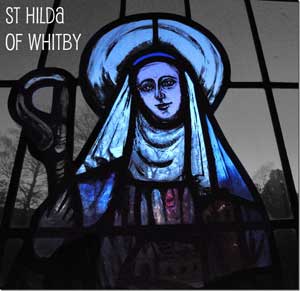
Haydock Place
Endeavour Cottage in Whitby located in the courtyard of Haydock Place.
The ammonite shells which abound in the vicinity of Whitby were believed to be so many petrified snakes. The inhabitants, according to the legend, besought St. Hilda to use her efforts that the nuisance might be abated and the snakes destroyed; and the saint is made to first pray their heads off, and then pray them into stone. These snake-stones (molusca shells), which are found in almost every place where alum rock exists, and particularly on Whitby Scar, between high and low water mark, are locally known as “fossils,” or “ammonites.” The fossilised animals, which are coiled up and resemble a headless snake in form, are found encased in hard elliptical stones or shells.
low water mark, are locally known as “fossils,” or “ammonites.” The fossilised animals, which are coiled up and resemble a headless snake in form, are found encased in hard elliptical stones or shells.
Sir Walter Scott thus refers to this legend in his poem “Marmion.”
"They told how in their convent cell.
A Saxon Princess once did dwell.
The lovely Edelfield
And how of thousand snakes, each one
Was changed into a coil of stone
When Holy Hilda prayed;
Themselves within their holy bound,
Their stony folds had often found.
They told, how sea-fowls' pinions fail,
As over Whitby's towers they sail,
And sinking down, with flutterings faint,
They do their homage to the saint.”
Another legend states that St. Hilda’s territory was so sacred that when sea-fowls attempted to fly over it they were constrained to do her homage, blowering their pinions and drooping to the ground?
Charlton, in his “History of Whitby,” says: “I shall procure only one instance more of the great veneration paid to Lady Hilda, which still prevails even in these our days (A.D. 1776), and that is, the constant opinion that she rendered, and still renders, herself visible, on some occasions, in the Abbey of Streonshalh, of Whitby, where she so long resided.
At a particular time of the year, namely, in the summer months, at ten or eleven in the forenoon, the sunbeams fall in the inside of the northern part of the choir; and ’tis then that the spectators who stand on the west side of the Whitby Churchyard, so as just to see the most northerlly part of the Abbey, past the north of Whitby Churc , imagine they perceive in one of the highest windows there the resemblance of a woman, arrayed in a shroud. Though we are certain this is only a reflection caused by the splendour of the sun’s beams, yet report says, and it is constantly believed among the vulgar, to be an appearance of Lady Hilda, in her shroud, or rather in her glorified state.”
A favourite story told in connection with the Abbey is one concerning its bells. It runs thus: The magnficent peal excited the cupidity of some sea roving freebooter who, landing with a sufficient force, extracted the bells from the sacred building, and conveyed them on board his vessel. This desecration was, however, not suffered to go unpunished, for, the vessel had got fairly under weigh, she struck, and foundered a short distance from a projecting ridge of rock called the “Black Nab.” As a fitting sequel to this, we are told that he who dares, on Hlallowe’en, to spend some time on the rock, and call his sweetheart’s name, will hear it echoed by the breeze accompanied by the ringing of marriage bells from the sunken chime.
Follow Us Please.
THE BURIED CHIME.
Below the cliffs at Whitby, when the great tides landward flow
Below the cliffs at Whitby, when the great winds landward
blow,
When the long billows heavily roll o'er the harbour bar
And the blue waves flash to silver ‘mid the seaweeds on
the Scar.
When! the low thunder of the surf calls down the hollow
Sore
And ‘mid the caves of Kettleness the baflled breakers roar
Under the cliffs at Whitbv whoso will stand alone _
Where in the shadows of the Nab. the eddies swirl and
moan
When to the pulses of the deep the flood tide rising swells
Will hear, amid its monotone, the clash of hidden bells.
Up from the heart of ocean the mellow music peals,
Where the sunlight makes its golden path. and the seamew
fiits and wheels
For many a chequered century, untired by flying time,
The lbells no human fingers touch have rung their hidden
cime. .
Since the gallant ship that brought them, for the abbey
on the height,
Struck and foundered in in the offing with her sacred goal
in sigght .
And the man who dares on Hallow’een on the Black Nab
to watch
Till the rose light on St. Hilda’s shrine the midnight
moon beams catch,
And calls his sweetheart by her name, as oer the sleeping
seas.
The echo of the buried bells comes floating on the breeze.
Ere another moon on Hallowe'en her errie rays has shed.
Will hear his wedding peal ring out from the church-tower
on the Head.
S. K. Phillips.
Back to Whitby History -Back to Whitby Blog
A walking guide of the town and its attractions click Whitby
Tweet - FB Like Us or G + Us..

Endeavour Cottage in Whitby located in the courtyard of Haydock Place.

Across the rooftops of Whitby towards the abbey

A view of Whitby Abbey from a cottage window.

We could provide high occupancy.
Want more booking for your holiday accommodation?
List your property with us. no contract red tape, no setup fee. Just bookings if and when you want them.
Whitby Holiday Cottages Letting Agency.